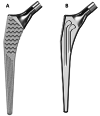Medium-term outcome of the Libra® cemented versus cementless stems in primary dual mobility total hip arthroplasty
- PMID: 37599372
- PMCID: PMC10440918
- DOI: 10.1186/s12891-023-06799-8
Medium-term outcome of the Libra® cemented versus cementless stems in primary dual mobility total hip arthroplasty
Abstract
Introduction: Despite the increasing use of cementless stems in total hip arthroplasty, the cemented stem has played a valuable role in the armamentarium of orthopedic surgeons. This study aims to compare two types of Libra® stems SERF, one cemented (Libra® C) and the other cementless hydroxyapatite coated (Libra® HA) that were conducted to analyze the medium-term outcome regarding their behavior and longevity.
Methods: This is a retrospective study for patients who received primary total hip arthroplasty with Dual Mobility (DM) articulation in the period between January 2014 to January 2020 with a minimum of two years follow-up. Two-hundred hips have been identified in 196 patients. One hundred forty-three Libra® cementless versus fifty-seven Libra cemented stems were implanted and the outcome of these stems is reported. All procedures were performed through the posterior approach and cemented stems were selected for elderly patients with wide medullary canals Dorr Type C. The indications for the index procedure were fractures, avascular necrosis, rheumatoid, and osteoarthritis. One hundred thirty-nine cementless DM cups were used while sixty-one hips had cemented Novae stick cups. Radiological evaluation for cup and stem positions, cement mantle, and radiolucent lines was performed, besides clinical function using the Harris Hip Score.
Results: The average age of patients was 60 ± 14.8. At the latest review, none of the cemented stems was revised or awaiting revision. One cementless stem was revised because of cortical perforation. Five intraoperative fractures were observed in the cementless group, but none of them needed revision or affected the stem stability. Readmission to theatre occurred in four patients to evacuate hematoma in two, a reduction of dislocation in one, and grafting bone lysis in one.
Conclusion: Cemented stems have an important role in osteoporotic patients with wide medullary canals with excellent outcomes and minimal risk of fracture.
Level of evidence: Level IV.
Keywords: Cemented; Cementless; Dual mobility, libra®; Total hip arthroplasty.
© 2023. BioMed Central Ltd., part of Springer Nature.
Conflict of interest statement
No competing interests.
Figures





Similar articles
-
Total hip arthroplasty for primary osteoarthritis in patients fifty-five years of age or older. An analysis of the Finnish arthroplasty registry.J Bone Joint Surg Am. 2008 Oct;90(10):2160-70. doi: 10.2106/JBJS.G.00870. J Bone Joint Surg Am. 2008. PMID: 18829914
-
Cementless hydroxyapatite-coated stem with dual mobility and posterior approach in over-80 year-old patients with osteoarthritis: Rates of dislocation and periprosthetic fracture at a mean 8 years' follow-up.Orthop Traumatol Surg Res. 2022 Apr;108(2):103196. doi: 10.1016/j.otsr.2021.103196. Epub 2021 Dec 24. Orthop Traumatol Surg Res. 2022. PMID: 34958972
-
Cementless augmented versus cemented Dual Mobility cups: medium-term outcome of case series with a control group.BMC Musculoskelet Disord. 2023 Feb 6;24(1):97. doi: 10.1186/s12891-023-06204-4. BMC Musculoskelet Disord. 2023. PMID: 36740673 Free PMC article.
-
A Systematic Review and Meta-Analysis of Non-database Comparative Studies on Cemented Versus Uncemented Femoral Stems in Primary Elective Total Hip Arthroplasty.J Arthroplasty. 2022 Sep;37(9):1888-1894. doi: 10.1016/j.arth.2022.03.086. Epub 2022 Apr 6. J Arthroplasty. 2022. PMID: 35398225
-
Does the Risk of Death Within 48 Hours of Hip Hemiarthroplasty Differ Between Patients Treated with Cemented and Cementless Implants? A Meta-analysis of Large, National Registries.Clin Orthop Relat Res. 2022 Feb 1;480(2):343-350. doi: 10.1097/CORR.0000000000001952. Clin Orthop Relat Res. 2022. PMID: 34491939 Free PMC article.
References
-
- Griffiths JT, Roumeliotis L, Elson DW, Borton ZM, Cheung S, Stranks GJ. Long term performance of an uncemented, Proximally Hydroxyapatite Coated, double Tapered, Titanium-Alloy femoral stem: results from 1465 hips at 10 years minimum Follow-Up. J Arthroplasty. 2021;36(2):616–22. doi: 10.1016/j.arth.2020.08.013. - DOI - PubMed
-
- Goyal D, Bansal M, Lamoria R. Comparative study of functional outcome of cemented and uncemented total hip replacement. J Orthop Traumatol Rehabilitation. 2018;10(1):23. doi: 10.4103/jotr.jotr_10_18. - DOI
MeSH terms
Substances
LinkOut - more resources
Full Text Sources
Medical
Research Materials

